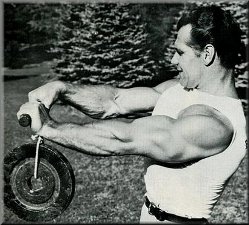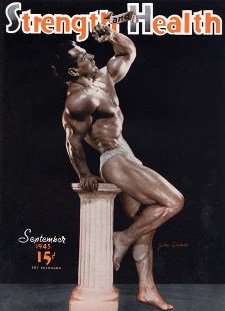John Grimek:
He was as strong as he looked.
Ask most people what they know of the 1936 Olympic Games and they will tell you about the USA’s Jesse Owens winning four Gold Medals in track and field. Few of them will know that it was also an Olympics in which a young man named John Carroll Grimek from Perth Amboy, New Jersey, represented the United States in weightlifting. Yet both men were to became iconic athletic figures.
This page is about Grimek, who was born in 1910, and at about age 12 began casually lifting a set weights owned by his older brother. By the 1930s, he had become a champion weightlifter, a member of the U.S. National Team and, in 1936, an Olympian.
In the 1930s, strongman events and Olympic style weightlifting competitions were not uncommon, but bodybuilding contests, as we know them, really weren’t around yet. Sometimes after lifting competitions or strongman shows some of the competitors might flex muscles for the audience. But that was the usual extent of it.

John Grimek trained to be a strongman, not a poser. The story is that he really didn’t like being around men who he thought strutted about and gazed in the mirrors too often. In fact, “I couldn’t stand ‘em,” he was quoted as saying.
The reluctant bodybuilder
Ironically, Grimek became the most well known physique competitor of his time.
Yet his transition to bodybuilding actually made more sense than you might think. In addition to being amazingly powerful, he also possessed physical symmetry and was talked into entering an early bodybuilding competition, the 1940 Mr. America contest. Which he won. Then he won it again the following year.
Not wanting the same man taking the title again and again, the governing body of the competition, the AAU (Amateur Athletic Union), decided to make it a rule that no one again could win the Mr. America title more than once. So Grimek became the only man to ever win Mr. America twice.
 But now he was enjoying bodybuilding competitions and went on to win other titles, such as Mr. Universe (1948), and Mr. U.S.A. (1949). He retired from bodybuilding competitions at age 39, never having been defeated.
But now he was enjoying bodybuilding competitions and went on to win other titles, such as Mr. Universe (1948), and Mr. U.S.A. (1949). He retired from bodybuilding competitions at age 39, never having been defeated.
Grimek was also exceptionally agile and good at hand balancing, tumbling and gymnastics. When “experts” of the day warned that weight training would render athletes “muscle bound,” Grimek would delight in exposing the fallacy by doing complete splits, incredible back bends, hand balancing, and gymnastics maneuvers.
In his training, as I understand it, he did not adhere to a static set of exercises from session to session, instead choosing to change the angles of movements from one workout to the next, inserting new exercises and removing others. If he thought a particular body-part needed more work, he simply added a few more exercises that focused on the area.
For half a century, anyone who trained with weights at all knew about and admired John Grimek. Until 1985, he was editor in chief of Muscular Development, which, along with Strength & Health magazine, was owned by Bob Hoffman’s York Barbell Company. And Grimek was really the public face of the company until he retired after 50 years. In retirement, he still continued serious training and was able to squat with over 400 pounds for reps in his late 60s.
John Grimek passed away on November 20, 1998, at age 88, in York, Pennsylvania. He was survived by his wife of 58 years, Angela, and their six children. He was inducted into the International Federation of Body Building (IFBB) Hall of Fame in 1999.
The following were his measurements during the time he won the Mr. America titles, in 1940 and 1941:
- Height: 5'8½"
- Weight: 195 lbs.
- Neck: 17 inches
- Arm: 17.5 inches
- Forearm: 14 inches
- Chest: 47 inches
- Waist: 31 inches
- Thigh: 25 inches
- Calf: 17 inches
- Wrist: 8 inches
- Ankle: 9.8 inches
John Grimek not only looked strong, he was strong. Super-strong.
Return fron John Grimek to the Muscle Stories page.
Enjoy this page? Please pay it forward. Here's how . . .
Would you prefer to share this page with others by linking to it?
- Click on the HTML link code below.
- Copy and paste it, adding a note of your own, into your blog, a Web page, forums, a blog comment,
your Facebook account, or anywhere that someone would find this page valuable.